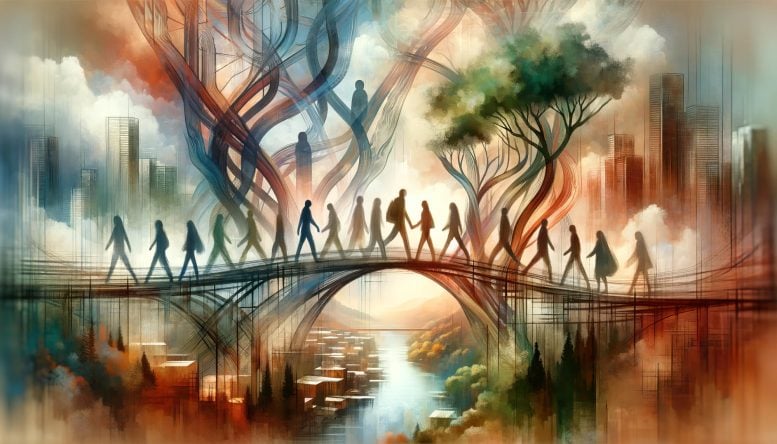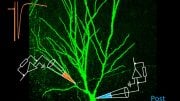
Kenneth Breslauer, a biophysical chemist at Rutgers, and his brother, George Breslauer, a political scientist at UC Berkeley, have co-authored a paper linking the concepts of stability in cells and social organizations. Their interdisciplinary study reveals striking parallels between the natural and social sciences, offering insights for enhancing institutional and political systems. Credit: SciTechDaily.com
A biophysical chemist from Rutgers and their older sibling, a political scientist at Berkeley, explore shared concepts.
A biophysical chemist at Rutgers and his brother, a political scientist based on the West Coast, have joined intellectual forces, realizing a long-standing dream of co-authoring an article that bridges their disciplines involving cells and society.
In their paper, they have proposed that powerful parallels exist between the microscopic, natural world of cells and molecules and the human-forged realm of organizations and political systems.
Taking it a step further, the brothers – eminent scholars who have served as top leaders of their respective institutions – have proposed that humankind can draw lessons from what the microscopic and macroscopic worlds have in common. Ideally, they said, their perspective could alert policymakers to strategies for responding adaptively to improve the performance of their institutions and political systems.
Distinguished Careers and Personal Background
Writing in the Proceedings of the National Academies of Science Nexus, Kenneth Breslauer, a Linus C. Pauling Distinguished Professor of Chemistry and Chemical Biology with the Rutgers School of Arts and Sciences (SAS), and his older brother, George Breslauer, a Chancellor’s Professor of Political Science at the University of California-Berkeley, have identified and analyzed similarities in rules that apply to both the natural and social realms.
“Our focus is particularly timely given the growing global challenges to various forms of governance and the emergence of history-changing biology,” said Kenneth, who has been a member of the Rutgers faculty for 50 years and is the university’s founding dean of life sciences. “Many stability-based concepts, characteristics, and phenomena within the physical sciences find analogous expression in the influences on the relative stabilities of socio-political systems.”
Kenneth, one the world’s foremost authorities on the forces that control the structure and function of biological molecules, was described in 2018 by former SAS Executive Dean Peter March as “the architect of our outstanding life science programs, which have helped establish Rutgers as a premier institution within the [Association of American Universities.]” In addition, Kenneth has been the dean of the Division of Life Sciences, the vice president for Health Science Partnerships, and the vice president for Research.
His brother George is recognized as a world-renowned expert in Soviet and Russian politics and foreign relations. In his area of expertise, he is the author of 14 books. At UC Berkeley, George has been the chair of the Center for Slavic and East European Studies, dean of the social sciences, executive dean of the College of Letters and Science, and executive vice chancellor and provost.
Born 14 months apart, the Breslauers grew up in Jackson Heights, Queens, raised by parents who were refugees from Nazi Germany.
“George and I are each other’s best friends,” Kenneth said.
The brothers have waited years to work together. Their paper, they said, is a “bucket list” item for both.
A Shared Concept: Stability in Different Spheres
The two used the shared concept of “stability” as their prism.
The molecular workings of microscopic systems such as a cell or molecule are generally understood to be subject to the laws of nature, the Breslauers said, while social and political events are thought to be structured by human action and chance. However, both natural, molecular systems and sociopolitical organizations, under the influences of analogous features, they said, exhibit some level of stability, instability and even “metastability,” a state of precarious stability.
For example, a chemical system can be metastable for extended periods of time, when it becomes trapped in a high energy state, until outside influences are sufficient to perturb and disrupt the stability of the trapped species. Analogously, isolated social states such as the former country of East Germany can persist in a metastable state for decades until the isolating boundaries are breached by outside influences.
The researchers likened a political science macroscopic concept, known as the “collective action” barrier, with the chemical property of cooperativity, which accelerates microscopic molecular transformations from one chemical state to another.
With respect to the societal collective action barrier, individuals who want to change an aspect of their government are less likely to act if they believe they are alone. Rather, they are more likely to advocate collectively for change if they believe they are one of many similarly-minded people.
Likewise, in the natural world, when molecules are arranged in an optimal configuration, they can collectively “snowball,” accelerating a chemical transformation. This phenomenon is known as a cooperative transition.
The Genesis of an Interdisciplinary Study
The idea for the study arose five years ago when the Breslauer brothers were strolling near Lincoln Center in Manhattan. George mentioned that his latest work had just been published. Kenneth asked George about the theme of his research that shaped the publications.
“He told me it was proposing what features allow certain social institutions to maintain stability for extended periods of time, a characteristic that can be referred to as ‘longitudinal persistence,’” Kenneth said. “George went on to identify about five characteristics that were necessary. I stopped him at that point and said, ‘George, you just described features that are completely analogous to what provides molecules with their stability.’”
Kenneth then realized that the microscopic molecular world he studied exhibited many analogous core features with the macroscopic societal world that his brother studied, particularly in terms of the features that allow systems to form, adapt, and persist, or rise and fall like the Roman Empire.
“One can think of a central government as the central nucleus of the cell,” Kenneth said. “Imagine regional governments as the embedded mitochondria and other specialized organelles. Carrying the analogy further, a country’s borders are analogous to the cell membrane.”
Kenneth added; “There are so many parallels between nature and society. Identifying and examining such structural, organizational, and functional analogs yields a wealth of information that is just waiting to be mined.”
Reference: “Political science meets physical science: The shared concept of stability” by George W Breslauer and Kenneth J Breslauer, 12 December 2023, PNAS Nexus.
DOI: 10.1093/pnasnexus/pgad401









This concept of parallels between “dissimilar” worlds is a common but usually unrecognized phenomenon. A link between consciousness and the physical world is the short term memory link that acts like RAM storage. Like when a person forgets some train of thought and goes back to the place where the forgotten association was made, suddenly it pops back into memory just from the visual association of surrounding objects. Many indigenous people have stories about how mountains or some features were made, that solidify a cultural memory. (we tend to call them myths) For example There are stone rings called Medicine wheels located around the Great Planes like calendars, where rocks are placed to locate the direction of rising starts or other celestial events associated with animal migration arrival. Those things are usually kept secret so far as they aren’t labeled so someone has to ask or do a lot of statistics. But for the people who DO know, it seems obvious and can be used any time.
woops, I meant rising stars, not rising starts